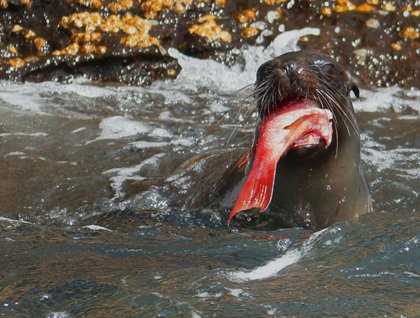The enchanted archipelago is full of surprises. Some come above land and others under the blue heart of the planet. As our wise and respected National Geographic Explorer Sylvia Earl always says, “First go blue and then go green,” and so we certainly started our day exploring the calm seas of the Galapagos in search of any cetaceans that could decide to perform a show for us. With luck, we were able to spot about 300 common dolphins heading to the northern side of Isabela Island. After breakfast, we crossed the equator line and were baptized with the permission of King Neptune to be able to explore his kingdom.
We arrive at Punta Vicente Roca, an outstanding visitor site with stunning geological features, not only tuff (compacted volcanic ash) and rusty lava with odd shapes but also the titanic cliffs that sheltered the National Geographic Islander as we anchored right in a cove with calm seas. We deployed our Zodiacs to ride along the coastline of Northern Isabela. The intertidal ecosystem was showing out of the water level because it was mid-tide, allowing us to spot many invertebrates among the large colonies of barnacles, anemones, and sun sea stars that decorated the low walls that stood up from the ocean itself. Many endemic species were spotted interacting along the shoreline. Some were eating, like a small Galapagos sea lion that had caught a Rosy scorpion fish and was kind enough to show us the fish from the moment he caught it, untill the last tip of the fish tail was down his throat.
As a naturalist, by experience I have a general idea of which species we might see and when, but at the same time, I actually never know what surprises these islands will have ready every day when we go out there and explore. The Galapagos penguins were just bathing on the surface of the ocean, some other were just basking under the sun on a rock, next to a small group of young Galapagos sea lions. These amazing sightings do not happen in many places in the world, and the fact that there are two species from opposite hemispheres and opposite habitats that came to Galapagos riding opposite currents, is just amazing (penguins come from the south on the cold Humboldt current and sea lions come from the north on the warm Panama current). We could never forget about the endemic flightless cormorants nesting on the shore. We snorkeled around the same cove, and this time the penguins got a bit closer to us underwater while these small fellows were fishing and having a buffet right in front of our eyes. Cormorants and several Pacific green sea turtles were spotted swimming in the area. While we were spotting some fish, a Pacific sea horse was spotted, but sadly it was eaten by a hog fish a few seconds later.
The National Geographic Islander repositioned and anchored at Punta Suarez on Fernandina Island. After a dry landing on a place full of mangroves and tide pools full of all sorts of offspring of marine organisms, we found the land of dragons in front of our eyes. Hundreds of large marine iguanas welcomed us here to enter the most pristine island in the Galapagos.
The black marine iguanas were covering large areas of the path to bask under the sun and sneeze salt out of their nostrils. This was the salt they gathered inside their bodies when diving under the ocean to graze on green algae. This is the only sea-going iguana in the world, endemic to the Galapagos of course!
The white sandy area used by the marine iguanas as a nesting ground on this island was uplifted in 1972 by tectonic movement. Ever since then the island shows a mix of black lava flows with shapes that only occur above the water level and also soft sandy areas like the bottom of the ocean. We definitely traveled back in time to explore the pristine taste of nature in the Galapagos - that unique essence only shown on an island where humans never had a major impact before.
Today, we were lucky to touch a place that had been so untouched by humans, to walk on the bottom of the ocean that now rises above sea level, and to imprint in our hearts and minds the unique experience the Galapagos Islands shared with us.









